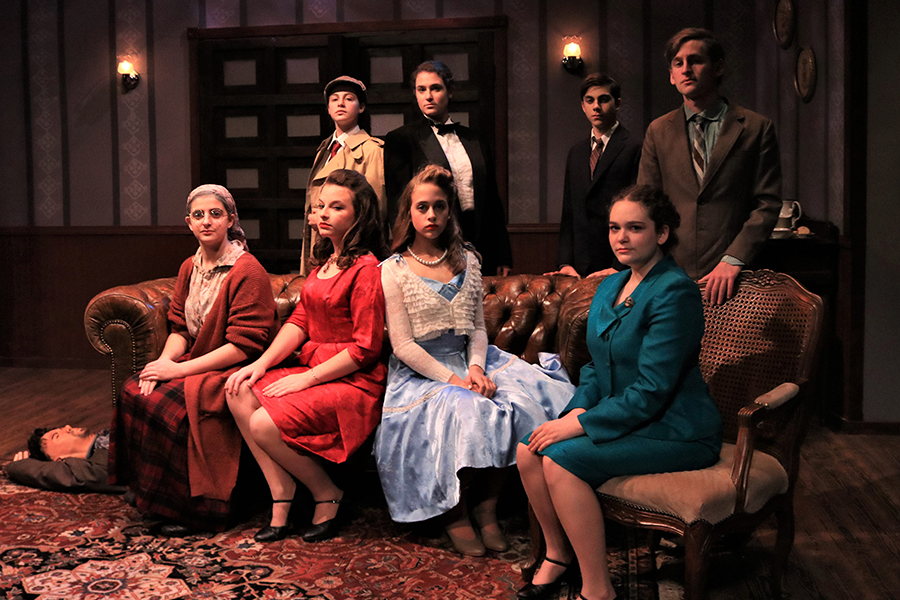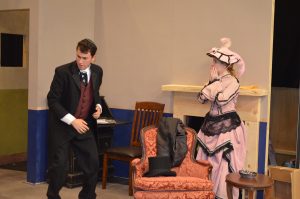Murder mystery ‘The Real Inspector Hound’ uses satire to show the real value of theater
Complicated plot drives actors and crew to push their limits in Drama’s fall mainstage production
January 2, 2020
In a good thriller mystery, you expect to hear gasps at the climax of the story. That one moment of pure surprise is so revered in mystery storytelling that artists try over and over again to recreate it in books, movies, television, plays — most of the time to no avail. Rarely is a director ever able to achieve the feat of creating that euphoric realization; The Real Inspector Hound is one of those rarities and so much more.
A one-act play written by Tom Stoppard and presented last month in the Wildfire Theater Lab, The Real Inspector Hound centers around two pompous theatre critics — Moon, who was played by Ariel Urman, and Birdboot, played by Jacob Lefkowitz Brooks — who watch a ridiculous whodunit murder mystery. Moon ridicules the play for lack of originality while barely paying attention to it, and Birdboot writes positive reviews of actresses he admires physically in hopes of dating them. Both critics are more interested in themselves than in their readers.
In the play the critics are watching, a killer is on the loose and unbeknownst to the characters, the victim is in their very house. Suspects include Simon Gascoyne, a dashing new man in town who was played by freshman Zach Rub and other characters played by Neima Fax, Rebecca Cohen, Lehava Segal and Zoe Ritz. Also suspected is Inspector Hound, who was played by junior Hannah Poltorak.
Any of these characters could be the murderer and the critics watching agree, until a shocking twist occurs: the critics enter the narrative of the play, stepping on the stage and changing its outcome. After Simon is killed within the play, Birdboot steps into the play and becomes the new Simon. After that, Moon steps into the play and becomes the new Inspector Hound. The play then restarts with the critics involved in the murder mystery as characters and suspects themselves.
The negative depiction of critics Moon and and Birdboot resonates well this year: in what was widely seen as one of the best years ever for female directors, the Hollywood Foreign Press Association didn’t see fit to nominate a single one for a Golden Globe Award. Greta Gerwig’s Little Women, Céline Sciamma’s Portrait of a Lady on Fire and Lulu Wang’s The Farewell were all ignored, in a snub not far from Birdboot and Moon’s dismissal of The Real Inspector Hound. In both cases, critics ignore not only directors but actors and craftspeople, showing little regard for what it takes to create these projects.
On the other hand, Stoppard was once a theater critic himself and so it’s reasonable to wonder whether he based the characters of Birdboot and Moon on some of those he knew. He has said his goal in writing Hound was not political, so perhaps he sought to give another side to the story: namely, that theater in all its components is worthy of respect.
As if to prove that point, this was not an easy play to act in. For example, Neima Fax had to break down emotionally on the floor not just once but twice, Jacob Lefkowitz had to jump over a sofa while continuing dramatic dialogue, and Ariel Urman had to memorize a hefty page-long monologue delivered at the climax of the story.
In fact, every actor excelled in his or her role, even ninth-graders like Zach, Zoe and Lehava, each whom was given a significant amount of dialogue and stage time. Every cast member seemed to push to the limit, showing Ms. Chase’s ability to pull great performances out of any student. Also executed with precision and perfect comedic timing were lighting and sound effects, run by Stage Manager Amy Cohen, and her Assistant Stage Manager, Haïm Oliel.
The realization moment at the climax of the play was likewise executed with audacity and originality: when Ariel’s Moon and Jacob’s Birdboot characters came onto the stage and entered the play narrative, many gasps were heard. The impossible feat was achieved and The Real Inspector Hound succeeded where many other whodunits failed.
But perhaps the production’s greater feat was that it shone equally in its other moments, accomplishing not only the meta-plot trick but also timeless messaging, outstanding directing and great feats of acting, all of which gave audiences much more to it than the excitement a moment of surprise.















